Northwest Florida is famous for its beautiful emerald coast, scattered with many beaches of white sand and crystal clear water. But this is just one of the natural treasures to grace the Sunshine State’s landscape. Florida is also home to over 3,000 self-sustaining colorful and flowering plant life. Although high temperatures and humidity make it hard for more delicate plants to thrive, native Floridian plants have evolved within their own ecological niches. These plants are suited to the local extreme climate and can survive without fertilization, irrigation or cold protection.
When we refer to native plants, we refer to natural species that occurred prior to European contact in Florida, according to the historical and scientific documentation available. These species are considered indigenous as they are present in vast habitats before human impact and alterations of the landscapes.
Plant species that are not native to Florida are said to be “naturalized”, referring to plants that did not originate in Florida, but however they got there, they now grow on their own and established habitat. Many naturalized plants can be invasive to Florida’s native plants as they interrupt the natural ecosystem processes, especially those that grow profusely. In addition to “naturalized” plants, it is also common to find “non-native” or “alien” plants, which are species that are not naturally occurring in Florida but rather have been intentionally or accidentally introduced to the landscape.
Florida has a massive array of native plants, and because of the resilience and adaptability of many of these species, the Florida Native Plant Society indicates that it is favorable to introduce native plants to our home gardens. These plants often flourish on their own, with little-to-no human intervention required, making them ideal in every way for the home gardener.
Between their unique and funky names, quirky characteristics and beautiful vibrant colors, the Sunshine States’ native plant life is fascinating and ideal for any plant lovers to learn about. Here are some of our favorite native Florida plants!:
American Beautyberry
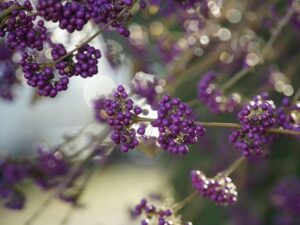
This colorful shrub grows everywhere in Florida. Its fantasy-grape-colored small balls make it very recognizable. The little purple fruits grow on each branch from late summer to early fall. This plant requires full to partial sun exposure and preferably nutrient-rich soils with presence of organic matter; it can however tolerate sandy soils.
Species name: Callicarpa Americana
Black Eyed Susan

This flowering plant shares a similarity with daisies, but is much more resistant to extreme weather conditions such as heat, drought, and even salt content in the air, making it an ideal plant for coastal areas. It requires full sun and will tolerate any soil type.
Species Name: Rudbeckia Hirta
Coontie

The Coontie, from the family of cycads, is a plant that has been around since the era of the dinosaurs. These are native to South Florida, and are the only cycads in North America. They grow low on the ground and their feathery leaves have a smooth texture. The Coontie can survive in any light conditions, be it full sun or full shade, and also tolerates most well-drained soils. Important: All parts of this plant are toxic if ingested, so please be cautious with pets and toddlers.
Species name: Zamia Integrifolia
Elliot's Aster
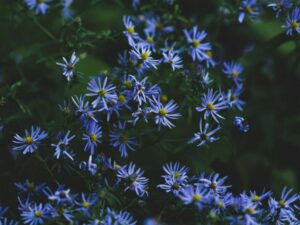
Elliot’s Astor requires full sun, and unlike many other flowering plants, which tend to bloom in spring and summer, these lavender colored flowers reveal their leaves in the late fall. This fragrant plant grows profusely and attracts butterflies, bees and other pollinators.
Species name: Symphyotrichum Elliottii
Firebush
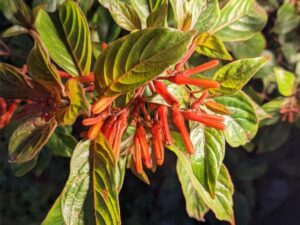
This plant received its name because of the clusters of bright red and orange tubular flowers that sprout from it during spring and through the winter. The shrub of this incredibly resilient species tolerates a range of adversities, such as drought, heat, pests and diseases, while its sunlight needs range from full sun to partial shade.
Species name: Hamelia Patens
Marsh Hibiscus
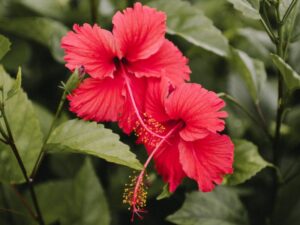
Marsh Hibiscus is Florida’s native hibiscus, and is sometimes also referred to as Swamp Mallow or Scarletrose Mallow. Its attractive deep red large petaled flowers bloom from mid to late summer, adding a beautiful touch of color to the landscape. Although this plant naturally occurs near streams, ponds and wetland, it can also tolerate drier soils.
Species name: Hibiscus Coccineus
Milkweed
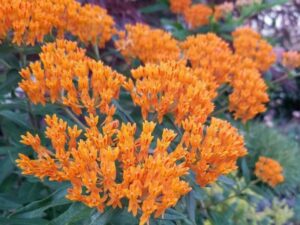
Milkweed is known to attract butterflies and bees with its nectar, and also serves as a host plant for caterpillars. There are several other variants of this plant, with different colored flowers, but the most common in Florida is the Butterfly Milkweed, with bright orange flowers (as seen in our photo). Whichever the variant, this plant thrives best under full sun and dry sandy soils.
Species name: Asclepias
Yucca
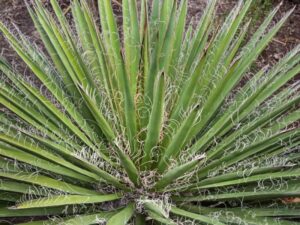
This plant can survive long periods without water and it is very similar to the succulent plants in that it needs a lot of sun and fast-draining soils. The Yucca is tolerant to high heat and humidity, which makes it a strong contender for Florida’s extreme climate. Its long and thin green spikey leaves characterize this resistant species.
Species name: Yucca
Tickseed
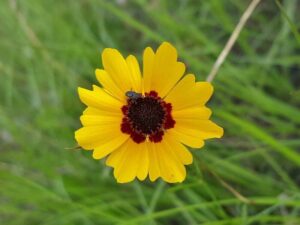
Here we have Florida’s official state flower. These sunshine-like flowers have the brightest yellow petals with a brown ring around the center. This plant has been used extensively in roadside landscapes and highway beautification programs. They flourish best under full sun but can also tolerate partial shade and almost any well drained soil.
Species name: Coreopsis
The above-mentioned plants are only a small number of the thousands of Florida native plants that can be discovered in the state. Next time you’re out and about, keep your eyes peeled and you will likely spot one or more of the plants you’ve learnt about in this blog.